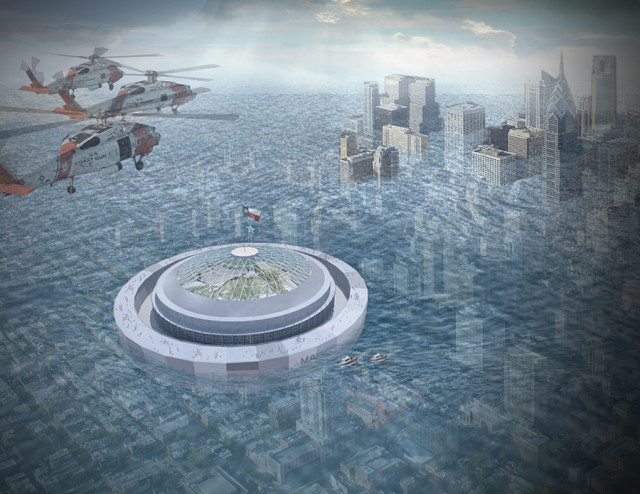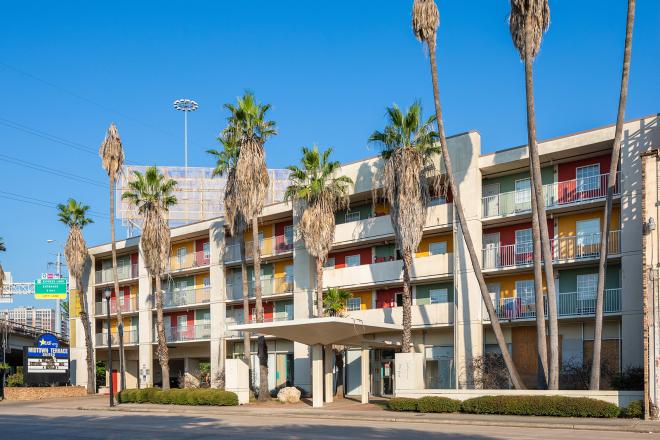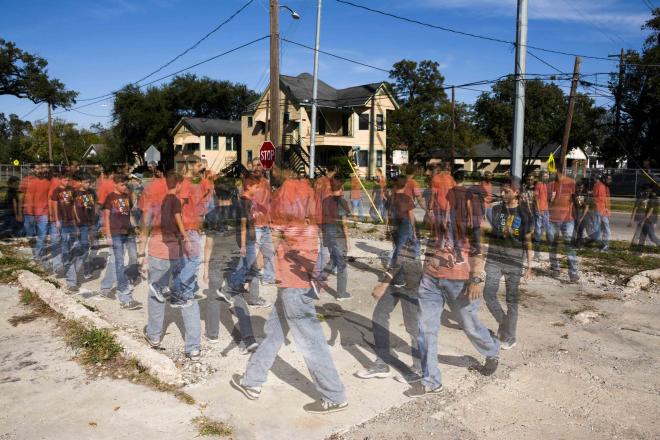Sea levels are rising. What will that mean for Houston? Will the Pierce Elevated become a diving platform and its ramps water slides?
One winning entry in an architecture competition to reimagine the Astrodome proposes a Houston Ark. The designers behind the entry, HiWorks with Erica Goranson, write an amusing story to go along with the images from a post-apocolyptic perspective 150 years in the future: "In 2046, when storm waters from the relatively weak Tropical Storm Rick breached the trillion-dollar [Ike Memorial Dike] and surged up the Ship Channel, Houston knew it had only a few years left to prepare . . . It was not a dramatic surge of a storm that moved the Houston Ark off its moorings. Instead it was the slow and incremental rise of the Gulf." Eventually the ark floats across what was the state of Florida.
Is this the type of scenario we face? Cite asked one of the foremost experts on sea level rise, Dr. John Anderson, W. Maurice Ewing Professor of Oceonography at Rice University, whose article, "Sea Level Change," appeared in the Winter 2014 issue (93).
Dr. Anderson does not mince his words regarding the scientific consensus on global warming. Indeed, he is known for standing up to an effort by the state of Texas to censor a report on Galveston Bay that he co-authored. For Cite, he is unequivocal about the role of humans in climate change. However, true to the caution of a reputable scientist, he does not predict a specific number for sea level rise along the upper Texas coast. Instead, he focuses on the rate of rise.
Very few scientists question global warming and the role humans have had in the process, while outside the science community it is largely viewed as a prediction. The reality is that climate change and associated accelerated sea-level rise are not predictions. Tide gauge records are supported by satellite data telling us that the rate of rise has significantly increased within the past two centuries. These combined results indicate that the rate of global sea-level rise averages ~3.0 mm/yr, although the actual rate varies regionally (Rahmstorf et al., 2007; Church et al., 2011; Carlson, 2011). However, within the northwestern Gulf of Mexico, subsidence contributes to relative sea-level rise with rates in east Texas as high as 6.0 mm/yr (Paine, 1993). Regardless of the actual value, this is a multifold increase over the long-term rate of the past few thousand years of ~0.40 to 0.60 mm/yr (Milliken et al., 2008).
A coin is about 1.5 mm thick. An average of 3 millimeters (mm) per year in sea-level rise doesn't sound all that bad, does it? Dr. Anderson clears up that possible misconception. He writes: "While an increase of only a few millimeters per year may seem insignificant, numerical models indicate that an increase of just 1 mm/yr in the rate of rise can result in an increase in the rate of shoreline retreat of several meters per year." He backs up this claim with references to several scientific studies (listed below) and two graphics. The first one shows the sea level of the Gulf over the last 10,000 years. In 8,000 B.C., when humans were building Çatalhöyük in Anatolia, the sea level along what is now Texas was 20 meters (66 feet) lower than now. When Jesus was born in Bethlehem, the sea level around here was just 1 meter lower than now (3 feet).
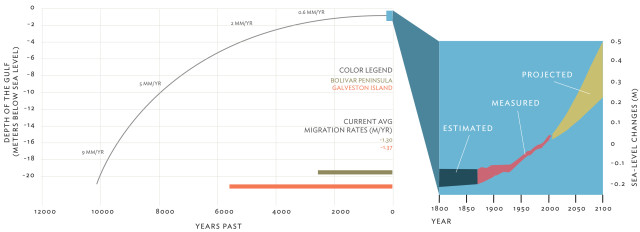 Galveston Tipping Points. Sea-level curve for the Northwestern Gulf of Mexico showing the long-term decline in the rate of rise over the past several thousand years. The blue box shows the historical (red) and projected (yellow) rate of rise. Note that modern barriers of the Upper Texas coast formed after the rate of rise had decreased to less than about 3 mm/yr, which is the current rate of rise (from Anderson et al., 2010). Click on image to enlarge.
Galveston Tipping Points. Sea-level curve for the Northwestern Gulf of Mexico showing the long-term decline in the rate of rise over the past several thousand years. The blue box shows the historical (red) and projected (yellow) rate of rise. Note that modern barriers of the Upper Texas coast formed after the rate of rise had decreased to less than about 3 mm/yr, which is the current rate of rise (from Anderson et al., 2010). Click on image to enlarge.
So, yes, the sea has been rising for a long time. What Dr. Anderson asks us to focus on, however, is not just the sea level itself but on the rate of rise, which you can see in the slope of the curve. It flattens out over millenia until the rate of rise is close to zero around 1800. Then, as you can see in a pull-out box, the rate of rise changes dramatically. Instead of flattening, it gets steeper. A 10,000-year arc flips in a 200-year period.
The second graphic shows the location of the shoreline back to 7,700 years ago when the Gulf Freeway --- had it existed --- would have taken you only about halfway to the beach. There was no Galveston Bay. And no Galveston Island. Looking at the map, you realize that we cannot take our geography for granted.
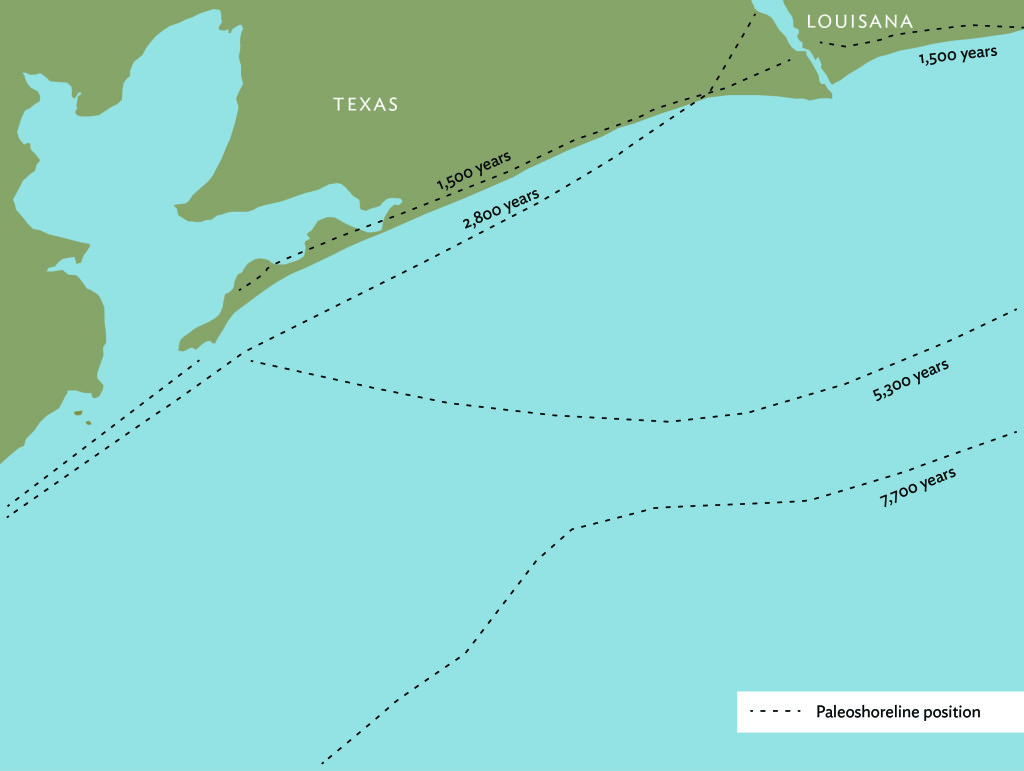 Paelolithic Shoreline. Changes in the upper Texas shoreline during the past 7,700 years. This map is based on years of marine geolgical research aimed at identifying past shoreline positions. Modified from Rodriguez et al., 2004. Click on image to enlarge.
Paelolithic Shoreline. Changes in the upper Texas shoreline during the past 7,700 years. This map is based on years of marine geolgical research aimed at identifying past shoreline positions. Modified from Rodriguez et al., 2004. Click on image to enlarge.
Dr. Anderson is no polemicist. He is more comfortable qualifying and complicating his claims than shooting rhetorical zingers. You get the sense he'd rather be on a boat collecting soil samples, but he feels compelled to share information that can inform policy. Buy a copy of Cite so you can read and re-read the full article. If you want a single take-home message, though, it is perhaps the following excerpt:
The acceleration of sea-level rise, coupled with minimal sediment supply to the coast, has resulted in increased rates of coaastal erosion, both along the Gulf Coast and within bays, and loss of wetlands (Morton et al., 2006; Paine et al., 2012). Thus, the first line of defense againt storm surge in more inland areas is being removed. At the same time, the population of the great Houston area continues to push south and into areas that are vulnerable to storm surge. The highly vulnerable Port of Houston and petrochemical industry at the ehad of galveston bay continues to expand. The City of Galveston refuses to adopt a setback policy for new construction along the Gulf shoreline. We are truly living in a 'state of denial.'
Though Dr. Anderson falls short of backing the proposal to turn the Astrodome into an ark, he is clear about a need for more research and debate informed by science. For more information, he writes, "The most widely published academic coastal scientists have joined together in the 'Gulf Coastal Science Consortium' intended to provide scientific information and advise on coastal issues."
In the video below, you can see Dr. Anderson speak (starting at 18:30) at the 2013 RDA Civic Forum on the challenges of climate change along with Dr. John Nielsen-Gammon, Texas State Climatologist; Eric Berger, Science Correspondent, Houston Chronicle; and Brent W. Dorsey, Director, Corporate Environmental Programs, Entergy Corporation.
References
Anderson, J.B., 2007. The Formation and Future of the Upper Texas Coast. Texas A&M Press, College Station, Texas.
Anderson, J.B., 2013. Coastal Processes and Environments Under Sea-Level Rise and Changing Climate: Science to Inform Management. GSA Today, 23, p. 13-14.
Anderson, J.B., Rodriguez, A.B. (Eds.), 2008. Response of Upper Gulf Coast Estuaries to Holocene Climate Change and Sea-Level Rise. Geological Society of America Special Paper 443, 146 pp.
Carlson, A. E., 2011. Ice Sheets and Sea Level in Earth’s Past. Nature Education Knowledge 3, 3.
Church, J. A., White, N. J., 2011. Sea-level rise from the late 19th to the early 21st century. Surveys in Geophysics 32, 585–602.
Elsner, J.B., Jagger, T.H., and Liu, K.B., 2008b. Comparison of hurricane return levels using historical and geological records. Journal of Applied Meteorology and Climatology, 47, 368–374.
Emanuel, K., 2005. Increasing destructiveness of tropical cyclones over the past 30 years. Nature, 436, 686–688.
Milliken, K.T., Anderson, J.B., and Rodriguez, A.B., 2008a. A new composite Holocene sea-level curve for the northern Gulf of Mexico. In: Anderson, J.B., Rodriguez, A.B. (Eds.), Response of Upper Gulf Coast Estuaries to Holocene Climate Change and Sea- Level Rise. Geological Society of America Special Paper 443, p. 1-11.
Morton, R.A., Bernier, J.C., Barras, J.A., 2006. Evidence of regional subsidence and associated interior wetland loss induced by hydrocarbon production, Gulf Coast region, USA. Environmental Geology 50, 261–274.
Paine, J.G., 1993. Subsidence of the Texas coast: inferences from historical and late Pleistocene sea levels. Tectonophysics 222, 445–458.
Paine, J.G., Sojan, M. Tiffany, C., 2012. Historical shoreline change through 2007, Texas Gulf Coast: rates contributing causes, and Holocene context. Gulf Coast Association of Geological Societies Journal 1, 13-26.
Rahmstorf, S., Cazenave, A., Church, J.A., Hansen, J.E., Keeling, R.F., Parker, D.E., Somerville, R.C.J., 2007. Recent climate observations compared to projections. Science 316, 709.
Rignot, E., Velicogna, I., van den Broeke, M.R., Monaghan, A., Lenaerts, J.T.M., 2011. Acceleration of the contribution of the Greenland and Antarctic ice sheets to sea level rise. Geophysical Research Letters 38, L05503, doi:10.1029/2011GL046583.
Rodriguez, A.B., Anderson, J.B., Siringan, F.P., and Taviani, M.,2004, Holocene evolution of the east Texas coast and inner continental shelf: along-strike variability in coastal retreat rates, Journal of Sedimentary Research, v. 74, p. 406-422.
Wallace, D.J., Anderson, J.B., 2010. Evidence of similar probablility of intense hurricane strikes for the Gulf of Mexico over the late Holocene. Geology 38, 511–
Webster, P.J., Holland, G.J., Curray, J.A., and Chang, H.R., 2005, Changes in tropical cyclone number, duration, and intensity in a warming environment. Science, 309, 1844–1846.



